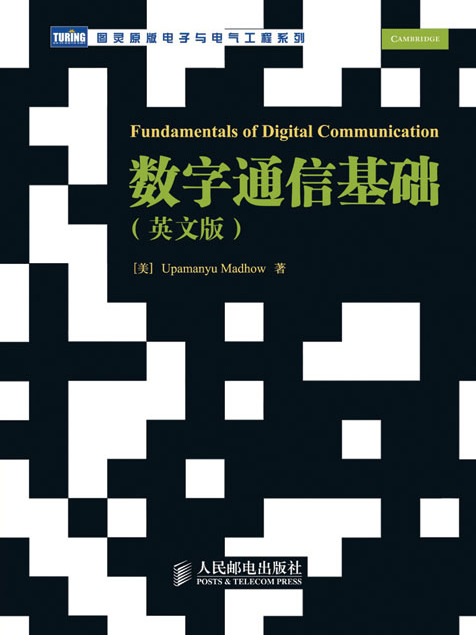《數字通信基礎(英文版)》是2010年3月人民郵電出版社出版的圖書,作者是[美]Upamanyu Madhow。
基本介紹
- 中文名:數字通信基礎(英文版)
- 作者:[美]Upamanyu Madhow
- ISBN:9787115223005
- 頁數:499頁
- 定價:69元
- 出版社:人民郵電出版社
- 出版時間:2010年3月
- 裝幀:平裝
- 開本:小16開

《數字通信基礎(英文版)》是2010年3月人民郵電出版社出版的圖書,作者是[美]Upamanyu Madhow。
《數字通信基礎(英文版)》是2010年3月人民郵電出版社出版的圖書,作者是[美]Upamanyu Madhow。內容簡介本書闡述了現代數字通信系統設計的基本知識,主要內容有:信號和噪聲的復基帶表述,調製和調解,分散信道通...
《Fundamentals of digital communication數字通信基礎》是2020年世界圖書出版公司出版的圖書。內容簡介 本書是一本講授數字通信系統設計基礎概念與原理的簡明教程。書中有大量從簡單到*前沿的實例來展示理論是如何指導實踐的。讀者可以用計算和...
《數字通信(第五版)(英文版)》是2019年10月電子工業出版社出版的圖書,作者是John G. Proakis(普羅科斯)、Masoud Salehi(薩利希)。內容簡介 本書是數字通信領域的一本優秀教材,既論述了數字通信的基本理論,又對數字通信的新...
《數字通信原理(英文版)》是2010年4月人民郵電出版社出版的圖書,作者是[美]Robert G·Gallager。內容簡介 本書是世界通信權威、信息領域泰斗Robert G. Gallager博士新作,在數字通信原理的基礎上精煉,重點闡述了理論、問題和工程設計...
從信號傳輸角度主要介紹了通信信號、數字調製、自適應均衡、多天線系統和最佳接收內容,從信息傳輸角度主要介紹了資訊理論基礎、信道容量和信道編碼等內容。《數字通信(第5版)(英文版)》取材新穎,討論問題系統全面、逐步深入、概念清晰,理論...
《數據通信與網路(英文版·第5版)》是2013年機械工業出版社出版的圖書,作者是Behrouz A.Forouzan。內容簡介 本書延續了Forouzan一貫的風格,以通俗易懂的方式全面闡述了網路技術及其套用。本書自第1版引進國內以來,對網路課程教學產生...
作者首先介紹了信號與系統的基礎理論和通信的核心問題,然後給出了設計和分析數字通信系統的工具。內容涵蓋基本的通信理論、必要的數學基礎及擴頻通信等現代通信技術。啟發性的講解方法、精心挑選的例題和更新的MATLAB 練習使本書成為易於被...
《數字與模擬通信系統(第八版)(英文版)》是2014年電子工業出版社出版的書籍,作者是Leon W. Couch II。圖書內容 本書在前七版的基礎上進行了修訂與更新,系統介紹了現代通信系統的基本理論和最新發展技術。全書共分8章,內容包括...
《數據與計算機通信(第十版)(英文版)》是2018年6月電子工業出版社出版的圖書,作者是William StallingsWilliam Stallings(威廉·斯托林斯)。內容簡介 本書是著名計算機專業作家William Stallings的經典著作之一,內容涉及基本的數據通信...
《數據與計算機通信(第九版)(英文版)》是2014年5月電子工業出版社出版的圖書,作者是William Stallings (威廉 . 斯托林斯)。內容簡介 本書是著名計算機專業作家William Stallings的經典著作之一,內容涉及基本的數據通信原理、各種類型...
《數字通信:基礎與套用(第2版)》重點論述數字通信的技術基礎和新套用。全書共分15章,詳細闡述了數字通信系統的基本信號變換、信號處理步驟、基帶信號及高斯噪聲中的信號檢測、帶通信號及其調製和解調技術、鏈路分析、各種信道編碼方法、...
數字設計(第四版)(含CD光碟1張) 徐志軍 2010/2/1 59 G0104360 通信信號處理 劉祖軍 2010/3/1 55 G0104720 數字通信——基礎與套用(第二版) 徐平平 等 2010/4/1 75 G0104770 Verilog HDL高級數字設計(第二版)(英文版) -...
《通信系統原理(英文版)》是2007年由電子工業出版社出版的圖書,作者是(美)普埃克。本書全面闡述了現代通信系統分析和設計所必需的基本原理,並對重要的數學基礎知識進行了回顧。內容簡介 本書由西安電子科技大學樊昌信教授改編,與原書...
4.1.3 數字信號 82 4.2 傳輸損傷和信道容量 82 4.2.1 有導向的傳輸介質 83 4.2.2 無導向的傳輸介質 86 4.2.3 信道容量 87 4.3 總結 89 4.4 關鍵術語、複習題和練習題 89 第5章 數據通信基礎 91 5.1 ...
從信號傳輸角度主要介紹了通信信號、數字調製、自適應均衡、多天線系統和最佳接收等內容;從信息傳輸角度介紹了資訊理論基礎、信道容量和信道編碼等內容。內容簡介 本書是數字通信領域一本優秀的經典教材,既論述了數字通信的基本理論,又對...
《現代數字與模擬通信系統(第4版)(英文版)》是電子工程領域理想的通信系統入門教材。作者首先介紹了信號與系統的基礎理論和通信的核心問題,然後給出了設計和分析數字通信系統的工具。內容涵蓋基本的通信理論、必要的數學基礎及擴頻通信等...
《無線通信基礎(英文版)》是2010年11月人民郵電出版社出版的圖書,作者是[美]David Tse、Pramod Viswanath。內容簡介 本書介紹無線通信的基本原理,著重強調概念及其在系統中的實現之間的相互影響,涉及的主要問題有MIMO通信、空時編碼...
《數字通信基礎》是2023年浙江教育出版社出版的圖書。內容簡介 《數字通信基礎》是在作者多年教學經驗和研究實踐的基礎上編寫而成的。我們力圖以較高的理論觀點和統一的處理方法介紹數字通信傳輸技術,在論述中力求概念準確,思路清晰,...
本書在Richard G. Lyons所著Understanding Digital Signal Processing, Second Edition的基礎上進行了改編,針對通信類學校本科教學大綱,刪除了教學中一般不涉及的內容,調整了章節順序,並增加了z反變換、濾波器結構、線性相位FIR濾波器和其...
《國外電子與通信教材系列·數字設計(第4版)(英文版)》可作為電氣工程、電子工程、通信工程和計算機工程或計算機科學等相關專業的教科書,也可作為電子設計工程師的參考書。《國外電子與通信教材系列·數字設計(第4版)(英文版)》是一本...
《網路通信技術 : [英文版] | Network Communications Technology影印版》是2002年科學出版社出版的圖書,作者是Ata Elahi。內容簡介 本書介紹了通信和網路的基礎知識以及網路涉及的技術層面,包括數據通信介質、調製解調技術、計算機協定、...
